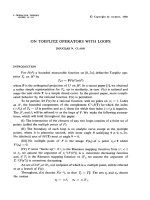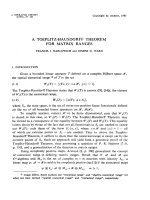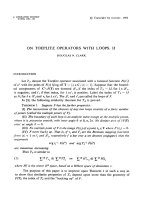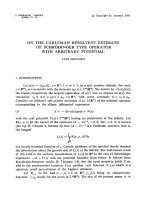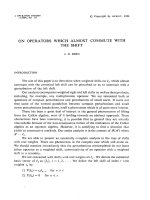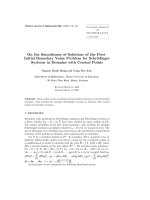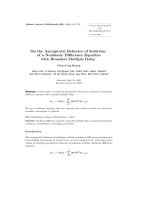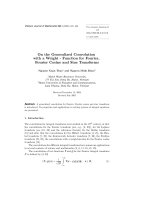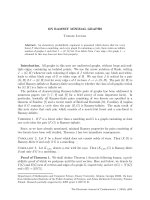Báo cáo toán học: "On Extremal Graphs With No Long Paths" docx
Bạn đang xem bản rút gọn của tài liệu. Xem và tải ngay bản đầy đủ của tài liệu tại đây (72.26 KB, 4 trang )
On Extremal Graphs With No Long Paths
Asad Ali Ali
Department of Computer Science
University of Mississippi
University, MS 38677
William Staton
Department of Mathematics
University of Mississippi
University, MS 38677
Submitted: October 31, 1995; Accepted: June 24, 1996
Abstract
Connected graphs with minimum degree δ and at least 2δ + 1 vertices have
paths with at least 2δ + 1 vertices. We provide a characterization of all such
graphs which have no longer paths.
Extremal problems involving paths and cycles have been considered since the
infancy of graph theory. The question which interests us here is the question of what
minimum degree condition guarantees a path of a preassigned length. This question
was answered by Erd¨os and Gallai [4] and again by Andrasfai [1]. Our formulation
of their answer is
Theorem 1 Let G be a connected graph with minimum degree δ and at least 2δ +1
vertices. Then G contains a path of at least 2δ +1vertices.
The complete bipartite graphs K
δ,n−δ
with n ≥ 2δ + 1 show that the theorem is best
possible in the sense that there exist graphs of minimum degree δ with no longer
paths. Our purpose in this article is to characterize all such extremal graphs.
For a graph G with n vertices we define f(G) to be the number of vertices in a
longest path of G, and for a vertex v of G we define f(v) to be the number of vertices
in a longest path of G with initial vertex v. A set of vertices is called independent if
no two of them are adjacent. By the sum H ⊕ K of two graphs we mean the graph
obtained from the disjoint union of H and K by adding edges joining every vertex of
the electronic journal of combinatorics 3 (1996), #R20 2
H to every vertex of K. All graphs considered here are simple. Definitions of terms
not explicitly given here can be found in [2].
Theorem 2 Let G be connected and v ∈ G. Suppose δ ≥ 2. Then f(v) ≥ 1+δ.If
f(v)=1+δ then every component of G − v is a K
δ
.
Proof: To show f(v) ≥ 1+δ,firstnotethatitistrivialforδ = 2. Suppose the
result is true for graphs with δ = k and let G have δ = k +1. Letv be a vertex of G
and note that G − v has minimum degree at least k.Letw be a neighbor of v.Then
there is a path of k + 1 vertices in G − v beginning at w. Hence there is a path in G
of k + 1 vertices in G − v beginning at w. Hence there is a path in G of k + 2 vertices
beginning with v followed by w. Now suppose that f(v)=1+δ. By Theorem 1, there
are paths of 2δ +1 vertices in G. Now v mustlieinthecenterofeverysuchpathP,or
else a path from v to P followed by the longer subpath of P would result in a path of
more than 1 + δ vertices beginning at v. Now consider the component or components
of G − v. Each such component has at least δ vertices or else the minimum degree of
G would be too small. We now claim that each component C of G − v has exactly δ
vertices. Let Q be a longest path in C ∪ v starting at v. Certainly the final vertex of
Q has all its neighbors on Q, forcing Q to have exactly δ + 1 vertices. Hence the final
vertex of Q is adjacent to all vertices of Q. Say Q: v = v
1
,v
2
, ···,v
1+δ
.Sincev
1+δ
is
adjacent to every v
i
, it follows that every v
i
, i =2, ···,δ+ 1, is the final vertex of a
longestpathinC∪ v starting at v,sayv
1
,v
2
, ···,v
i−1
,v
δ+1
,v
δ
, ···,v
i
. Hence v
i
has
all its neighbors on Q, so the component C consists only of the vertices v
2
, ···,v
δ+1
and these are all adjacent, proving the theorem. ✷
Theorem 3 IfGisconnectedandf(G)=2δ +1, δ ≥ 2 then
i) If G has no cut vertex and n ≥ 2δ +2 then G = H ⊕ I where H has δ vertices
and I is an independent set.
ii) If G has a cut vertex v, then G is the union of copies of K
δ+1
with vertex v in
common.
Proof:
i) Since G has no cut vertex, Theorem 4 of [3] assures us that there is a cycle of
at least 2δ vertices. Let C, with vertices v
1
,v
2
, ···,v
2δ
in cyclic order be such a
cycle. First we claim the vertices not on C are independent, for if x and y are
adjacent and neither is on C, then since G is connected, there is a path from x
to a vertex of C. Hence there is a path which includes x, y and all 2δ vertices of
C, contradicting f (G)=2δ + 1. It follows that vertices not on C have all their
the electronic journal of combinatorics 3 (1996), #R20 3
neighbors on C. Since n ≥ 2δ + 2, there are at least two such vertices, say x and
y. Note that the neighbors of x must be either v
1
,v
3
, ···,v
2δ− 1
or v
2
,v
4
, ···,v
2δ
,
for if x were adjacent to two consecutive vertices of C, then x could be inserted
between them yielding a cycle of 2δ + 1 vertices. In this case, any edge from y
to C would yield a path of length 2δ + 2. It follows that every vertex not on
C has either the odd vertices or the even vertices of C as its neighbors. Sup-
pose that x is adjacent to v
1
,v
3
, ···,v
2δ−1
and y is adjacent to v
2
,v
4
, ···,v
2δ
.
Then v
1
,x,v
3
,v
2
,y,v
4
,v
5
, ···,v
2δ
is a path of 2δ + 2 vertices, contradicting
f(G)=2δ+1. It follows that every vertex not on C has the same neighbors, say
v
2
,v
4
, ···,v
2δ
. We now show that no two odd numbered vertices of C are adja-
cent. Suppose 1 ≤ i<j≤ 2δ − 1withi and j odd and v
i
adjacent to v
j
.Then
the vertices x, v
i−1
,v
i
,v
j
,v
j−1
,v
j−2
, ···,v
i+1
,y,v
j+1
,v
j+2
, ···,v
2δ
,v
1
,v
2
, ···,v
i−2
form a path of 2δ + 2 vertices. This again contradicts f(G)=2δ + 1. It follows
that the vertices not on C along with the odd numbered vertices of C form an
independent set I. Let H be the graph induced by the even numbered vertices of
C. All that remains is to show that every odd numbered vertex of C is adjacent
to every even numbered vertex of C. Since an odd numbered vertex of C can
have no neighbor in I, the minimum degree condition forces it to be adjacent
to every vertex of H.
ii) Now suppose f(G)=2δ +1, with δ ≥ 2, and suppose G has a cut vertex
v. Note that every path beginning at v lies (except for v) entirely in a single
component of G − v. Since each such component has minimum degree at least
δ − 1, there are paths of δ + 1 vertices beginning with v lying in any component
C. If there were a longer path from v into any such component, then attaching
such a path with a path of length greater than or equal to δ + 1 vertices from
another component of G − v would yield a path longer than 2δ + 1 vertices in
G. It follows that f (v)=1+δ. By Theorem 2 each component of G − v is
K
δ
. To ensure minimum degree δ, v must be adjacent to every vertex of every
component of G − v. ✷
Summarizing, we now know all extremal graphs, G with f (G)=2δ +1. The
connected extremal graphs are those given in Theorem 3 along with the trivial ones
with only 2δ + 1 vertices.
We noticed that the proof of Theorem 3 is easily modified to provide a charac-
terization of non-hamiltonian graphs which barely miss satisfying Dirac’s condition.
We are sure this must be known, but we have not found it in the literature. We
are grateful to Arthur Hobbs [6], who made us aware of reference [5] where there are
results similar to our Theorem 4.
the electronic journal of combinatorics 3 (1996), #R20 4
Theorem 4 Let G be a graph with δ = k and n =2k +1 vertices. If G is not
hamiltonian then:
i) If G has a cut vertex, then G is the union of two complete graphs K
k+1
sharing
avertex;
ii) If G has no cut vertex, then G is H
k
⊕ I
k+1
where H
k
is a graph with k vertices
and I
k+1
is an independent set of k + 1 vertices.
Proof: Note that the degree condition and size of n force G to be connected.
i) This follows immediately from Theorem 1 and Theorem 3.
ii) In this case, by Theorem 4 of [3], there is a cycle C of 2k vertices. Let v be
the vertex not on C. Say C: w
1
,w
2
, ···,w
2k
in cyclic order. If v were adjacent
to two consecutive vertices of C, G would have a hamiltonian cycle. Hence we
may assume v is adjacent precisely to the w
i
with i even. As in the proof of
Theorem 3, the odd indexed w
i
are independent. Let I
k+1
= v, w
1
,w
3
, ···,w
2k−1
and let H
k
be the subgraph induced by w
2
,w
4
, ···,w
2k
. The Theorem follows. ✷
References
[1] B. Andrasfai, Paths, Circuits, and Loops of Graphs, (Hungarian) Mat. Lapok
13 (1962) 95-107.
[2] G. Chartrand and L. Lesniak, Graphs and Digraphs, 2nd Edition, Wadsworth,
Belmont, California, 1986.
[3] G. A. Dirac, Some Theorems on Abstract Graphs, Proc. London Math Soc. 2
(1952) 69-81.
[4] P. Erd¨os and T. Gallai, On Maximal Paths and Circuits of Graphs, Acta Math.
Acad. Sci. Hung. 10 (1959) 337-356.
[5] L. Gordon, Hamiltonian Circuits in Graphs with Many Edges, (unpublished).
[6] A. Hobbs, Private Communication.
